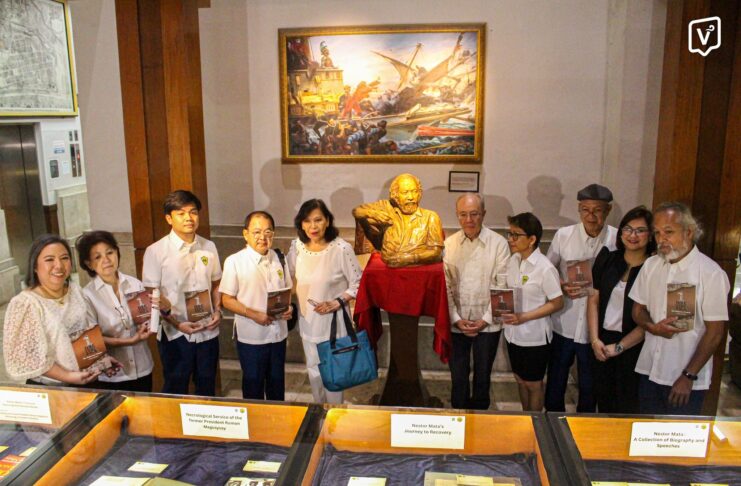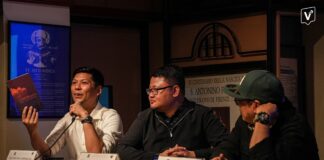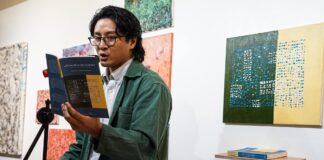Isa para sa lahat
MULA sa kaniyang pananaw bilang Pilipinang dayuhan sa ibang bansa na nangungulila sa kinagisnang wika at bansa, pinanday ni Elynia S. Mabanglo ang Mesa Para sa Isa (UST Publishing House, 2002), isang librong maaaring makapagbigay depinisyon sa makabagong Pilipino.
Sa mga piling tulang ito ni Mabanglo, ipinakikita ng makata ang tumitibok na diwa ng karanasan ng tao tulad ng mga karanasan niya habang nagtuturo ng Filipino at panitikang Filipino sa Unibersidad ng Hawaii-Manoa.
Pinagtagpi-tagping panitikan
HINDI na bago sa pandinig ang mga Pilipinong manunulat na naninirahan sa ibang bayan. Magmula kay Jose Rizal hanggang kay Jessica Hagedorn, makikita na patuloy na umuusbong ang panitikang Filipino sa ibang bansa. Ngunit nakabubuti nga ba ito sa ating bayan o nagpapahiwatig lamang ng lalong pagkakawatak-watak ng lahing Pilipino?
Sa isang panayam sa Varsitarian, pinatunayan nina Jose Wendell Capili, Marianne Villanueva at Ninotchka Rosca na ang pagiging makabayan ay hindi natatapos sa sandaling tumapak ang isang Pilipino sa lupaing banyaga.
Suede and Velvet
CAUGHT at night in the bustling city, Sonia lingered inside the quaint coffee shop where she usually soothed herself after a tedious week of work at the advertising firm. While smoking cigarettes, she drank coffee to calm her nerves until she fell into a state of wakeful dreaming where the senses seemed to merge into a hazy spell.
It was in this state that Sonia found herself under a familiar gaze.
“Adam!” she shouted as the face registered in her thoughts. Adam returned the greeting with a hug and treated Sonia to a feast of Japanese dishes in a nearby restaurant.
The past in the eyes of Filipino storytellers
SIGNIFICANT literary traditions in Philippine fiction in English were tackled last June 29 commencing the University of the Philippines (UP) Likhaan Centennial Lecture Series, titled, “Fiction as Response to History: Philippine Fiction in English,” by Cristina Pantoja-Hidalgo, UP Vice President for Public Affairs and former Likhaan director.
Chicken soup for the Filipino youth
PART of growing up is the in-between world of innocence and maturity, and the Filipino dimension to this developmental limbo is portrayed and problematized in Growing Up Filipino (Philippine American Literary House, 2004), a collection of short stories for young adults edited by Cecilia Manguerra Brainard.
Making it through the literary maze
THESE days, media-hyped potboilers, paranormal anthologies, and international tear-jerkers crowd many shelves. But every now and then, there is that cranial knock that yearns for reading of another kind: reading that engages the brain cells, and at the same time tugs at the heartstrings.
Now, how can one make the right choice? When most readers are not adept at literature, or blessed with a worthy literary pedagogue, to judge by the cover is not an option.
Between cradle and coffin
COLD and damp in darkness’ study, we stand
Armed with nothing but swords to cleave the air
Against foes who know where our blows will land.
To bleed for victory, what heart would dare?
All scores consumed by unfurling defeat:
By refusing-parry from one held dear,
Or when one pierces us to shamed retreat,
Heroic knees fail, to the earth draw near.
Drop our guard, and rob our grave of flowers,
Sheath in salt, the sword meant to gash death’s cheek,
And maim the giver of hallowed powers,
Thus, no euphoric life is left to seek.
But in mankind’s sempiternal making
All our labyrinthine jokes find meaning.
New York in a nutshell
THOUSANDS of dreams have been realized in New York. As for author Carissa Villacorta, the Big Apple not only held the key to her dreams but also to her identity.
Dwelling on the erratic lifestyle of a New Yorker is Surreality (UST Publishing House, 2006), composed of 14 essays written by Villacorta who contributes for the US broadsheet Philippine News. Recognized by the Philippine New York Junior Chamber of Commerce for her outstanding achievement in contemporary literature, Villacorta narrates her life-changing, four year sojourn in New York through her collection.
Villacorta kicks off each essay with a teaser, called “Roller Coaster Ride,” which tells of her random musings about New York. Making this part more vivid is the use of photographs featuring images of Times Square, subway stations, and the author’s immediate family.
Postmodernism, anyone?
DEATH of the author? Postmodern writing seeks nothing less than the death of writing itself.
According to UST Graduate School professor Florentino Hornedo, postmodernism is an overturning of the conventions of writing.
In his book, Free Fall: Postmodernism, Hornedo calls the postmodern style as “free play,” where everything is permissible.
“Postmodern literature avoids structures, foundations, and big narratives,” Hornedo told the Varsitarian.
One of the major traits of postmodern writing is that it denies concepts that used to be the sole source of themes for literary pieces, such as universality, science, socialism, and even the existence of God.
“The one rule that it follows is to not follow any of the rules,” he said.
Many fictionists and poets today refuse to follow the rules of conventional writing, which they find suffocating to freedom of expression.
Out of the box

As a child, I found room in boxes,
Four walls mounting into a firmness
Resembling my father’s hand.
Rays of light seep in between spaces,
As shadows loom and reappear from my sight.
But now, these once empty spaces
Only hold tattered clothes and naked crayons
Slowly fading into oblivion.
Their walls transformed into planks—
A barrier shielding light, where even
My shadow cannot hide in.
Outside the box, I have seen more light,
Painting my skin yellow and warm,
Diminishing my shadow.
As I dance with the wind, the boxes
Tumble down, corroding mercilessly
Under the nebulous blue skies.
Kristine Joy L. Dabbay












